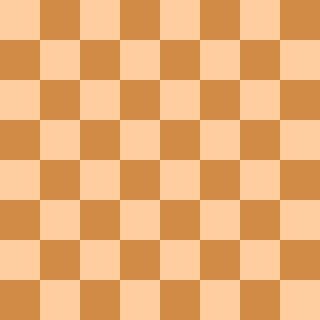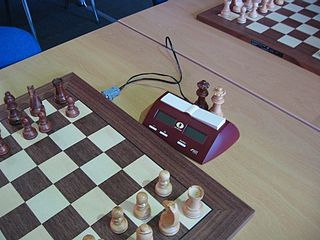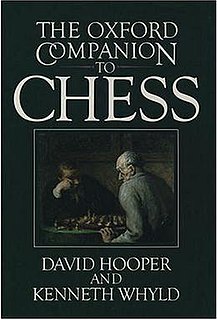In chess, a pin is a situation brought on by an attacking piece in which a defending piece cannot move without exposing a more valuable defending piece on its other side to capture by the attacking piece. Moving the attacking piece to bring on the pin is called pinning; the defending piece so restricted is described as pinned.
Descriptive notation is a notation for recording chess games, and at one time was the most popular notation in English- and Spanish-speaking countries. It was used in Europe until it was superseded by algebraic notation, introduced by Philipp Stamma in 1737. Algebraic notation is more concise and requires less effort to avoid ambiguity, but much older literature uses descriptive notation. Descriptive notation exists in many language-based variants, the most prevalent being English descriptive notation and Spanish descriptive notation. Natural language was generally used to describe moves in early chess literature and is the ultimate source of all forms of descriptive notation. Over time, abbreviations became common, and a system of notation gradually evolved. By the time of Howard Staunton's The Chess-Player's Handbook (1847), a common first move for White was recorded as "P. to K's 4th.", which was later reduced to "P-K4". In the back of the book, Staunton offers brief descriptions of long algebraic notation, noting its adoption by "Alexandre, Jaenisch, the 'Handbuch,' and in Germany generally", and of "Koch's Notation", now generally known as ICCF numeric notation.

Losing Chess is one of the most popular chess variants. The objective of each player is to lose all of their pieces or be stalemated, that is, a misère version. In some variations, a player may also win by checkmating or by being checkmated.
The Babson task is a particular type of chess problem, namely, a directmate with the following properties:
- White makes the only move that forces checkmate in the stipulated number of moves.
- Black's defences include the promotion of a certain pawn, to either a knight, a bishop, a rook, or a queen.
- If Black promotes, then White must promote a pawn to the same piece that Black just promoted to - this is the only way to force checkmate within the stipulated number of moves.
This page explains commonly used terms in chess problems in alphabetical order. For a list of unorthodox pieces used in chess problems, see Fairy chess piece; for a list of terms used in chess is general, see Glossary of chess; for a list of chess-related games, see List of chess variants.

A Grimshaw is a device found in chess problems in which two black pieces arriving on a particular square mutually interfere with each other. It is named after the 19th-century problem composer Walter Grimshaw. The Grimshaw is one of the most common devices found in directmates.
The Novotny is a device found in chess problems named after its discoverer Antonín Novotný. A white piece is sacrificed on a square where it could be taken by two different black pieces - whichever black piece makes the capture, it interferes with the other. It is essentially a Grimshaw brought about by a white sacrifice on the critical square.
The Plachutta is a device found in chess problems: a white piece sacrifices itself on a square where it could be captured by one of two similarly moving black pieces moving along a different line; whichever black piece captures, it interferes with the other. Plachutta theme is named by Joseph Plachutta (1827–1883).

A helpmate is a type of chess problem in which both sides cooperate in order to achieve the goal of checkmating Black. In a helpmate in n moves, Black moves first, then White, each side moving n times, to culminate in White's nth move checkmating Black. Although the two sides cooperate, all moves must be legal according to the rules of chess.

The Evergreen Game is a famous chess game, won by Adolf Anderssen against Jean Dufresne in 1852.

The Grünfeld Defence is a chess opening characterised by the moves:

Eugène Rousseau was a French chess master. He was the strongest chess player in New Orleans in the first half of the 1840s. The Rousseau Gambit is named after him.
In the game of chess, interference occurs when the line between an attacked piece and its defender is interrupted by sacrificially interposing a piece. It is a chess tactic which seldom arises, and is therefore often overlooked. Opportunities for interference are rare because the defended object must be more valuable than the sacrificed piece, and the interposition must itself represent a threat.

En passant is a move in chess. It is a special pawn capture that can only occur immediately after a pawn makes a double-step move from its starting square, and it could have been captured by an enemy pawn had it advanced only one square. The opponent captures the just-moved pawn "as it passes" through the first square. The result is the same as if the pawn had advanced only one square and the enemy pawn had captured it normally.

Petrov's Defence or the Petrov Defence is a chess opening characterised by the following moves:

A check is a condition in chess, shogi, and xiangqi that occurs when a player's king is under threat of capture on their opponent's next turn. A king so threatened is said to be in check. A player must get out of check, if possible, by interposing a piece between the threatening piece and the king, capturing the threatening piece, or moving the king to a square where it is no longer in check. If the player cannot move out of check, the game ends in checkmate and the player loses. Players cannot make any move that puts their own king in check.

In chess, a double check is a check delivered by two pieces simultaneously. In chess notation, it is almost always represented the same way as a single check ("+"), but is sometimes symbolized by "++". This article uses the latter convention for clarity.

Promotion is a chess rule that requires a pawn that reaches its eighth rank to be immediately replaced by the player's choice of a queen, knight, rook, or bishop of the same color. The new piece replaces the pawn, as part of the same move. The choice of new piece is not limited to pieces previously captured, thus promotion can result in a player owning, for example, two or more queens despite starting the game with one. Pawn promotion, or the threat of it, often decides the result in an endgame. Since the queen is the most powerful piece, the vast majority of promotions are to a queen. Promotion to a queen is often called queening; promotion to any other piece is referred to as underpromotion.








